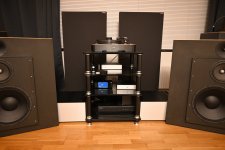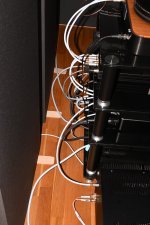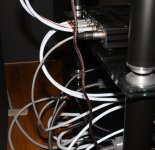Super BF8 build Gary!! You meticulously fit all the bits and pieces in the chassis, nice! I like the old school turret strips, a bit of Toobz influence 🙂.
Well done!

Well done!

For my Lazy Singing Bush is was necessary to put the SMPS's in its own chassis to avoid magnetic induced noise.
For my two F8 mono blocks I swapped them (uses classis CRCLC filtering). They are mirrored chassis so by swapping them I could use 0.6-0.7m RCA cables insted of 1m. I had those shorter RCA cables already. Next I will look at the mains cables to have the correct length and get screened cables.
Regarding the sound when comparing:
DAC --> Iron Pre (12 dB) --> Lazy Singing Bush
vs
DAC --> F8
DAC in preamp mode and my Iron Pre is just a box with RCA in/out (no pot).
My first observation was the bass response appeared more "dry" and tight (fast). I really like the bass response from this amp.
After listening to various music I have a feeling that the "heights" (treble) is a bit more emphasized and very detailed.
I needed to move speakers a little bit from each other to have space for the larger mono blocks. Then I moved the listening position also a bit back to have the perfect "triangle". I usually sit a bit more back than the distance between the speakers.
Stereo imaging is great and amps are very silent when no signal is applied.
Amps handles complex classical music very well.
For my two F8 mono blocks I swapped them (uses classis CRCLC filtering). They are mirrored chassis so by swapping them I could use 0.6-0.7m RCA cables insted of 1m. I had those shorter RCA cables already. Next I will look at the mains cables to have the correct length and get screened cables.
Regarding the sound when comparing:
DAC --> Iron Pre (12 dB) --> Lazy Singing Bush
vs
DAC --> F8
DAC in preamp mode and my Iron Pre is just a box with RCA in/out (no pot).
My first observation was the bass response appeared more "dry" and tight (fast). I really like the bass response from this amp.
After listening to various music I have a feeling that the "heights" (treble) is a bit more emphasized and very detailed.
I needed to move speakers a little bit from each other to have space for the larger mono blocks. Then I moved the listening position also a bit back to have the perfect "triangle". I usually sit a bit more back than the distance between the speakers.
Stereo imaging is great and amps are very silent when no signal is applied.
Amps handles complex classical music very well.
What ratings do you guys use on lyts first and ev second C (with lower ripple) for 24ish vdc and for 32ish vdc respectively? Voltage, ripple and temp?
Yea well, I’m studying alternatives. Big mojo threaded terminal ones are easy from diy perspective but price/performance is generally bad to snap in or common radial. They are big and bulky to. Common radial and snap in usually cheaper per performance figures. Snap In I think is hardest in diy cause mounting usually takes a circuit board. Common radial can just be stacked on perfboard
I have now played my F8 mono blocks for some time. I am extremely satisfied. It is the most silent setup I ever had.
Some images attached from my setup. I spend some time on the connections (RCA, mains cables) so they are only as long as needed.
All mains cables screened. It maybe looks like a mess but it is quite well organized I think.
My source is a Bluesound Icon network player (Qobuz hi-res agreement). From router I use a Supra CAT8+ cable. Should be fast enough for Hi-res music.
Output from Icon goes directly to F8 (0.6-0.7m RCA cable).
Other source is turntable. I use Pearl3 riaa and output goes into the analog input of Icon (0.3-0.4m RCA cable). An ESS ES9826 SABRE® ADC takes care of that. That solved the volumen problem. I use digital volumen. This turntable setup is by far the most silent I have had. Then from Bluesound app I can switch between the two sources.
3D imaging is extremely good and I like the "silence" around instruments. It is easy to pinpoint every instrument / voice in the 3D image.
For normal critical listening level vol is about 65-70%. For just nice background level vol is about 40-50%.
Treble is crisp and still "silky".
Difficult to describe sound. Only solution is to come and listen 🙂
Some images attached from my setup. I spend some time on the connections (RCA, mains cables) so they are only as long as needed.
All mains cables screened. It maybe looks like a mess but it is quite well organized I think.
My source is a Bluesound Icon network player (Qobuz hi-res agreement). From router I use a Supra CAT8+ cable. Should be fast enough for Hi-res music.
Output from Icon goes directly to F8 (0.6-0.7m RCA cable).
Other source is turntable. I use Pearl3 riaa and output goes into the analog input of Icon (0.3-0.4m RCA cable). An ESS ES9826 SABRE® ADC takes care of that. That solved the volumen problem. I use digital volumen. This turntable setup is by far the most silent I have had. Then from Bluesound app I can switch between the two sources.
3D imaging is extremely good and I like the "silence" around instruments. It is easy to pinpoint every instrument / voice in the 3D image.
For normal critical listening level vol is about 65-70%. For just nice background level vol is about 40-50%.
Treble is crisp and still "silky".
Difficult to describe sound. Only solution is to come and listen 🙂
Attachments
hm.......
maybe I need to build one for my self?
need to go back in thread, to see on pictures what iteration is on T-Bed right now
listening to it for several weeks now, but forgot which one
most likely Babelfish F8m, ikebana style
easy to mix-up, as all my amps are sounding the same

maybe I need to build one for my self?
need to go back in thread, to see on pictures what iteration is on T-Bed right now
listening to it for several weeks now, but forgot which one

most likely Babelfish F8m, ikebana style
easy to mix-up, as all my amps are sounding the same

It is strange that it is possible to make such simple amp that good with only 3 (4) transistors and with 15-16 dB of voltage gain.
MoFo is simpler but it has no voltage gain. Therefor F8 is the perfect amp for Hi-Res streaming and with digital volumen.
Yes, build one 🙂 .....I think you will like it.
Now I use analog input of Icon for TT which goes via ADC.......why not make the riaa correction in digital domain?
Then "anti-pop" filters could be implemented but that is probably another topic.
Right now the ADC / DAC takes everything. Every pop/crack is played back 100% natural.
MoFo is simpler but it has no voltage gain. Therefor F8 is the perfect amp for Hi-Res streaming and with digital volumen.
Yes, build one 🙂 .....I think you will like it.
Now I use analog input of Icon for TT which goes via ADC.......why not make the riaa correction in digital domain?
Then "anti-pop" filters could be implemented but that is probably another topic.
Right now the ADC / DAC takes everything. Every pop/crack is played back 100% natural.
we tend to see some things as novelty, even if they aren't
but, as with everything, even if amp (as object of contemplation) is made of trivial itsybitsies, manner of their combination is what can give special quality as result
few random thoughts:
- FE per se, seen zillion times from dawn of SS amps, remember - everything was simple (JLH amp, anyone?)
- low resistances in FB network, yes even that seen
- Mu follower OS - being here from toobz era
now, Pa sez more than once, he's seeing himself as "Conceptualist"
as I see it, that's someone as Court Jester, combining known words and sentences (read- itsybitsies) in own personal and especially peculiar way, and throwing them in faces
So, he "just" took 3 above lined ingredients, adjusted what needed to be adjusted to get desired functionality, and that's it
Everything is easy when:

but, as with everything, even if amp (as object of contemplation) is made of trivial itsybitsies, manner of their combination is what can give special quality as result
few random thoughts:
- FE per se, seen zillion times from dawn of SS amps, remember - everything was simple (JLH amp, anyone?)
- low resistances in FB network, yes even that seen
- Mu follower OS - being here from toobz era
now, Pa sez more than once, he's seeing himself as "Conceptualist"
as I see it, that's someone as Court Jester, combining known words and sentences (read- itsybitsies) in own personal and especially peculiar way, and throwing them in faces

So, he "just" took 3 above lined ingredients, adjusted what needed to be adjusted to get desired functionality, and that's it
Everything is easy when:
- you're smart
- have mileage
- eager to work
Everything is easy when:
and even easier when you have what to Babelfish
Imo, what makes this amp so special is combination of:
-super fast and clean sound
-unusually high dynamic (one could easily think it is not a Class A amp with only 1 pair of output devices)
-powerfull and precise bass/mid/high
-huge and super airy sound stage
-smooth sounding
-and maybe most important - "specific SS tonality/timbar"
It is always fun to listen!
Mine is biased little higher (~2A).
-super fast and clean sound
-unusually high dynamic (one could easily think it is not a Class A amp with only 1 pair of output devices)
-powerfull and precise bass/mid/high
-huge and super airy sound stage
-smooth sounding
-and maybe most important - "specific SS tonality/timbar"
It is always fun to listen!
Mine is biased little higher (~2A).
Hello, sir. After the Babelfish f8 operates for a few minutes, its temperature gradually rises. Meanwhile, the low-frequency performance gradually deteriorates, and the mid-frequency becomes very thin. I think this situation is caused by the large thermal internal resistance of the power amplifier tubes. I'd like to ask if it's possible to parallel an additional pair of IRFP150s just like in the Aleph 3. I plan to modify the resistors on each pair of power tubes to a combination of 0.33 ohms and 0.68 ohms. What do you think? Is it feasible?
- Home
- Amplifiers
- Pass Labs
- Babelfish F8



